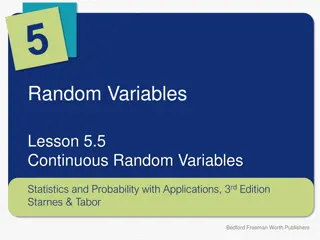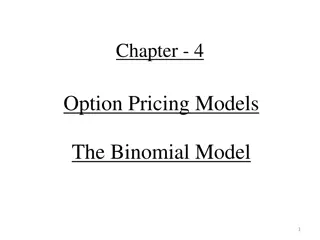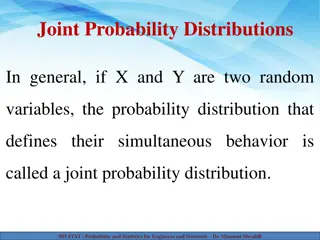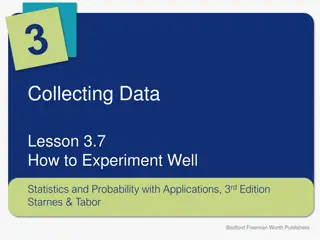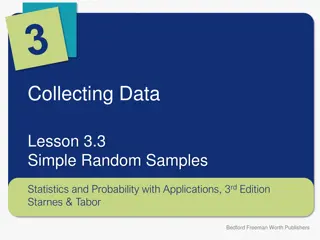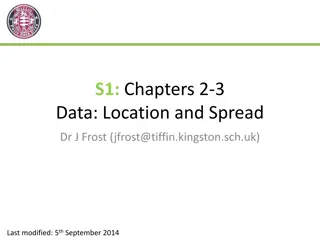Understanding Binomial Random Variables in Statistics
Binomial random variables arise when independent trials of the same chance process are conducted and the number of successes is recorded based on specific conditions. This lesson covers the characteristics of a binomial setting, such as binary outcomes, independence of trials, fixed number of trials, and consistent probability of success. Examples like playing roulette or analyzing NFL coin toss outcomes help in identifying scenarios that fit the binomial setting criteria.
Download Presentation

Please find below an Image/Link to download the presentation.
The content on the website is provided AS IS for your information and personal use only. It may not be sold, licensed, or shared on other websites without obtaining consent from the author. Download presentation by click this link. If you encounter any issues during the download, it is possible that the publisher has removed the file from their server.
E N D
Presentation Transcript
Random Variables Lesson 5.3 Binomial Random Variables Statistics and Probability with Applications, 3rdEdition Starnes & Tabor Bedford Freeman Worth Publishers
Binomial Random Variables Learning Targets After this lesson, you should be able to: Determine whether or not a given scenario is a binomial setting. Calculate probabilities involving a single value of a binomial random variable. Make a histogram to display a binomial distribution and describe its shape. Statistics and Probability with Applications, 3rdEdition 2 2
Binomial Random Variables When the same chance process is repeated several times, we are often interested in how many times a particular outcome occurs. Binomial Setting A binomial setting arises when we perform several independent trials of the same chance process and record the number of times that a particular outcome (called a success ) occurs. The four conditions for a binomial setting are: Binary? The possible outcomes of each trial can be classified as success or failure. Independent? Trials must be independent; that is, knowing the result of one trial must not tell us anything about the result of any other trial. Number? The number of trials n of the chance process must be fixed in advance. Success? There is the same probability p of success on each trial. B I N S Statistics and Probability with Applications, 3rdEdition 3 3
Would you rather play roulette ball or football? Would you rather play roulette ball or football? Identifying binomial settings Identifying binomial settings PROBLEM: Determine whether or not the given scenario describes a binomial setting. Justify your answer. (a) An American roulette wheel has 38 equally-sized slots into which a ball will fall randomly. There are 18 red slots, 18 black slots, and 2 green slots. Successive games of roulette will be played until the first time the ball falls into a green slot. Binary? Success = ball lands on green. Failure = ball doesn t land on green. Independent? Knowing the color of the slot the ball falls into on one play tells you nothing about the color of the slot another play. Number? There is not a fixed number of trials. Because there is not a fixed number of trials, this is not a binomial setting. In addition, the random variable is counting the number of trials until a success, not the number of successes in a fixed number of trials, which is not a binomial random variable. Statistics and Probability with Applications, 3rd Edition 4 4
Would you rather play roulette ball or football? Would you rather play roulette ball or football? Identifying binomial settings Identifying binomial settings PROBLEM: Determine whether or not the given scenario describes a binomial setting. Justify your answer. (b) Professional football teams in the NFL must play 16 regular season games. Each game begins with a coin toss to determine who gains possession of the ball first. Suppose one team is chosen and you record the number of times they win the coin toss in one season. Binary? Success = wins the coin toss. Failure = doesn t win the coin toss. Independent? Knowing the outcome of one coin toss tells you nothing about the outcome of another coin toss. Number? n = 16 Same probability? p = 0.50 This is a binomial setting. Statistics and Probability with Applications, 3rd Edition 5 5
Binomial Random Variables When checking the Binary condition, note that there can be more than two possible outcomes per trial. In the Pop Quiz activity, each question (trial) had five possible answer choices: A, B, C, D, or E. If we define success as guessing the correct answer to a question, then failure occurs when the student guesses any of the four incorrect answer choices. Binomial Random Variable The count of successes X in a binomial setting is a binomial random variable. The possible values of X are 0, 1, 2, . . . , n. Statistics and Probability with Applications, 3rd Edition 6 6
Binomial Random Variables How can we calculate probabilities involving binomial random variables? Binomial Probability Formula Suppose that X is a binomial random variable with n trials and probability p of success on each trial. The probability of getting exactly k successes in n trials (k = 0, 1, 2, ..., n) is where The binomial probability formula looks complicated, but it is fairly straight forward if you know what each part of the formula represents: P(X = k) = (# of ways to get k successes in ntrials) (success probability)k(failure probability)n k Statistics and Probability with Applications, 3rd Edition 7 7
Who won the toss? Who won the toss? Using the binomial probability formula Using the binomial probability formula PROBLEM: Professional football teams in the NFL must play 16 regular season games. Each game begins with a coin toss to determine who gains possession of the ball first. What is the probability that one team wins the coin toss in exactly 13 of their 16 games? Let X = the number of coin tosses won in a season. X is a binomial random variable with n = 16 and p = 0.50. ? ? = ??=????? ?.??? ? ?.??? ?? = ??? ?.??? ?.?? = ?.???? Statistics and Probability with Applications, 3rd Edition 8 8
Binomial Random Variables What does the probability distribution of a binomial random variable look like? Binomial Distribution The probability distribution of a binomial random variable is a binomial distribution. Any binomial distribution is completely specified by two numbers: the number of trials n of the chance process and the probability p of success on any trial. X = the number of children with type O blood This binomial distribution with n = 5 and p = 0.25 has a clear right-skewed shape. Statistics and Probability with Applications, 3rd Edition 9 9
What degrees do Americans hold? What degrees do Americans hold? Graphing a binomial distribution Graphing a binomial distribution PROBLEM: According to recent government statistics, 11.8% of all Americans aged 25 or over hold a Master s degree, Professional degree, or Doctoral degree. Randomly select 6 Americans aged 25 or over and let X = the number (out of these 6) that hold such a degree. Make a histogram of the probability distribution of X. Describe its shape. The graph is skewed right with a single peak at X = 0. (Notice that X = 4, X = 5, and X = 6 have such low probabilities that their bars cannot be seen on this scale.) Statistics and Probability with Applications, 3rd Edition 10 10
LESSON APP 5.3 Is the train binomial? According to New Jersey Transit, the 8:00 A.M. weekday train from Princeton to New York City has a 90% chance of arriving on time on a randomly selected day. Suppose this claim is true. Choose 6 days at random. Let X = the number of days on which the train arrives on time. 1. 2. 3. Explain why this is a binomial setting. Calculate and interpret P(X = 4). Make a histogram of the probability distribution of X. Describe its shape. Statistics and Probability with Applications, 3rd Edition 11 11
LESSON APP 5.3 1. Explain why this is a binomial setting. Is the train binomial? 2. Calculate and interpret P(X = 4). Statistics and Probability with Applications, 3rd Edition 12 12
LESSON APP 5.3 3. Make a histogram of the probability distribution of X. Describe its shape. Is the train binomial? Statistics and Probability with Applications, 3rd Edition 13 13
Binomial Random Variables Learning Targets After this lesson, you should be able to: Determine whether or not a given scenario is a binomial setting. Calculate probabilities involving a single value of a binomial random variable. Make a histogram to display a binomial distribution and describe its shape. Statistics and Probability with Applications, 3rd Edition 14 14








